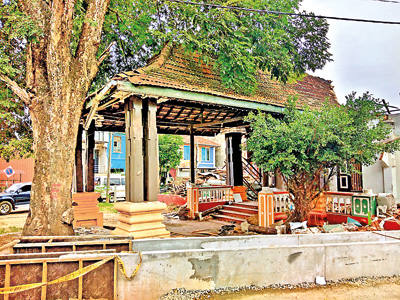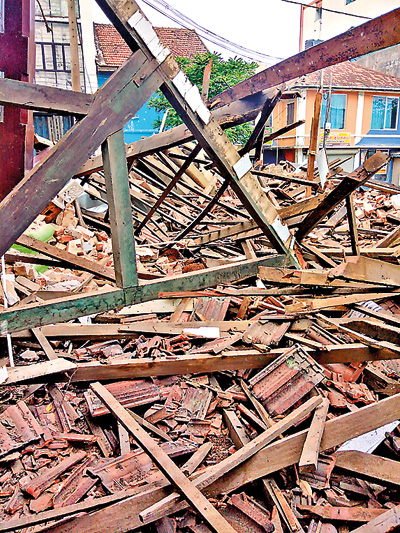News
Right royal ruin over a ‘royal’ pavilion
The destruction of a supposed archeological heritage site in Kurunegala–reportedly the royal pavilion of King Buwanekabahu II–caused outrage this week, even entering the political arena and prompting finger-pointing among Government officials over who was responsible.

The archeological value of the building was in dispute throughout the continuing controversy
The archeological value of the building was in dispute throughout the continuing controversy. The new town was constructed during the British period on the foundations of the ancient Kurunegala kingdom, said T M C Bandara, Exploration Officer of the Special Unit for the Prevention of Destruction and Theft of Antiquities of the Archaeology Department. Therefore, areas such as these–Kotte is another example–have less ruins, as they grew more populated.
The Antiquities Ordinance holds that any building with a history before March 2, 1815, is by default a location of archeological value and is thereby protected under the Act. Separately, the Cultural Property Act states that any property with historic value from the 1815 to 1920 period must be specifically gazetted by the relevant Minister in order to receive protection under the law.
The royal pavilion of King Buwanekabahu II was renovated by the British. Mr Bandara speculates that this is probably why it is disputed that the site is one of archeological value.
But the reign of King Buwanekabahu II dates back to the start of the 14th century. Therefore, the structure–heavily influenced by Kandyan architecture–is deemed protected under the Antiquities Ordinance even without gazetting. 
“The renovations made by British colonizers do not dictate the historic period that the structure belongs to because the foundation dates to a period before March 2, 1815,” he maintained.
Commenting on its use as a hotel–the Buwaneka Hotel–Mr Bandara noted that “living heritage” sites were common preservation techniques used in Sri Lanka. He pointed to prominent addresses such as the Dutch Hospital and the Cargills Building in Colombo that were renovated to suit the needs of the times.
Kurunegala Mayor Thushara Sanjeewa is facing a severe backlash for his role in the demolition. He claimed it was “completely fallacious” to describe the site as the royal pavilion of King Buwanekabahu II. He pointed to a 2019 document from former Director General of Archaeology Prof P B Mandawala.
In it, the Professor has referred to the Buwaneka Hotel as belonging to the British colonial period, Mr Sanjeewa claimed. He also said the alleged royal pavilion is not in a list of sites from the ancient kingdom period.
“So without even a gazette to prove its archeological value, why are people fighting so hard to protect something our oppressors built?” he questioned. He said the building was under the Kurunegala Municipal Council (MC) since the 1930s.
“It may be over 100 years old, but it is not an archeological heritage site,” the Mayor insisted, adding that the hotel had a liquor licence and also functioned as a brothel.
“Just come and ask anyone living in the town and they’ll tell you,” he said. Mr Sanjeewa has given his testimony through a lawyer to the authorities and wants a transparent inquiry. This whole controversy is a “political ploy” aimed for the elections, he asserted.
The Mayor described how the building came to be destroyed. The Road Development Authority (RDA) was widening the road in front of the site and drain construction required a portion of the premises to be removed. The area had toilets that were built recently.
During this removal, a wall of the pavilion also collapsed on June 24 this year, Mr Sanjeewa said. On July 14, the entire edifice was pulled down. In between, the Archaeology Department had not said a word to him, he claimed.
“The Archaeology Department regional office is about 50 meters away from the site,” he said. “What were they doing for so long?”
Stores were built out of tin in the space the toilets previously stood to stack oils and other building materials. Another wall broke away due to rains and other natural causes, the Mayor continued. Officials were notified of this and the MC decided to empty the stores for fear of the oil barrels catching fire. A backhoe was brought to remove rubble at approximately 7 p.m. on July 14. During that process, another wall had collapsed.
RDA officials denied responsibility for the destruction that occurred on July 14. Initial projects to develop the Ambepussa-Kurunegala-Trincomalee main road started in 2014, said Athula Senadeera, North Western Provincial Director. Due to legalities related to land acquisition, the project couldn’t meet deadlines. Certain parts of the road, therefore, remained undeveloped.
The Buwaneka Hotel in Kurunegala town was one property on this route. Legal clearance required for land acquisition was completed and the project entered its final stage this year. To widen the road in front of the hotel, the plan required a small part of the premises to be taken down.
The Kurunegala MC, which held ownership, was notified via registered post in May this year. Pointing to its historic features, the RDA also asked the Archaeology Department for input via registered mail. The letter was copied to the MC.
The necessary demolition was done by the MC and construction of the drainage system began on June 26. It ended on July 3. “During this whole time, we had no opposition or protest from any authority,” Mr Senadeera noted.
He believes the problem started with the removal of a few “wedge stones” from a culvert under the road in front of the site for the new drain. The Archaeology Department lodged a complaint with the Kurunegala police in this regard on July 8. The Chief Engineer from the Kurunegala RDA office reported for a hearing at the police station–but nobody from the Archaeology Department turned up. The complaint, therefore, was not taken up.
On July 15, the Archaeology Department, the RDA and Kurunegala police carried out a field inspection. They decided not to remove any more wedge stones. The RDA immediately ceased road development activities in the site area and notified this in writing to the Archaeology Department. The Provincial Director concluded his letter by pointing out that the area which was affected had not even been proposed by the RDA for removal.
After the fact, the Prime Minister appointed an investigative committee headed by Director General of Archaeology Professor Senarath Dissanayke. It submitted its interim report on Wednesday. Prof Dissanayake said legal action has been initiated and he could not comment.
Apart from recommending legal action, the committee has proposed that expenses be charged from the MC for rebuilding the property at the earliest using Archaeology Department records. The RDA has been called upon to revise its plans to bypass the building.

